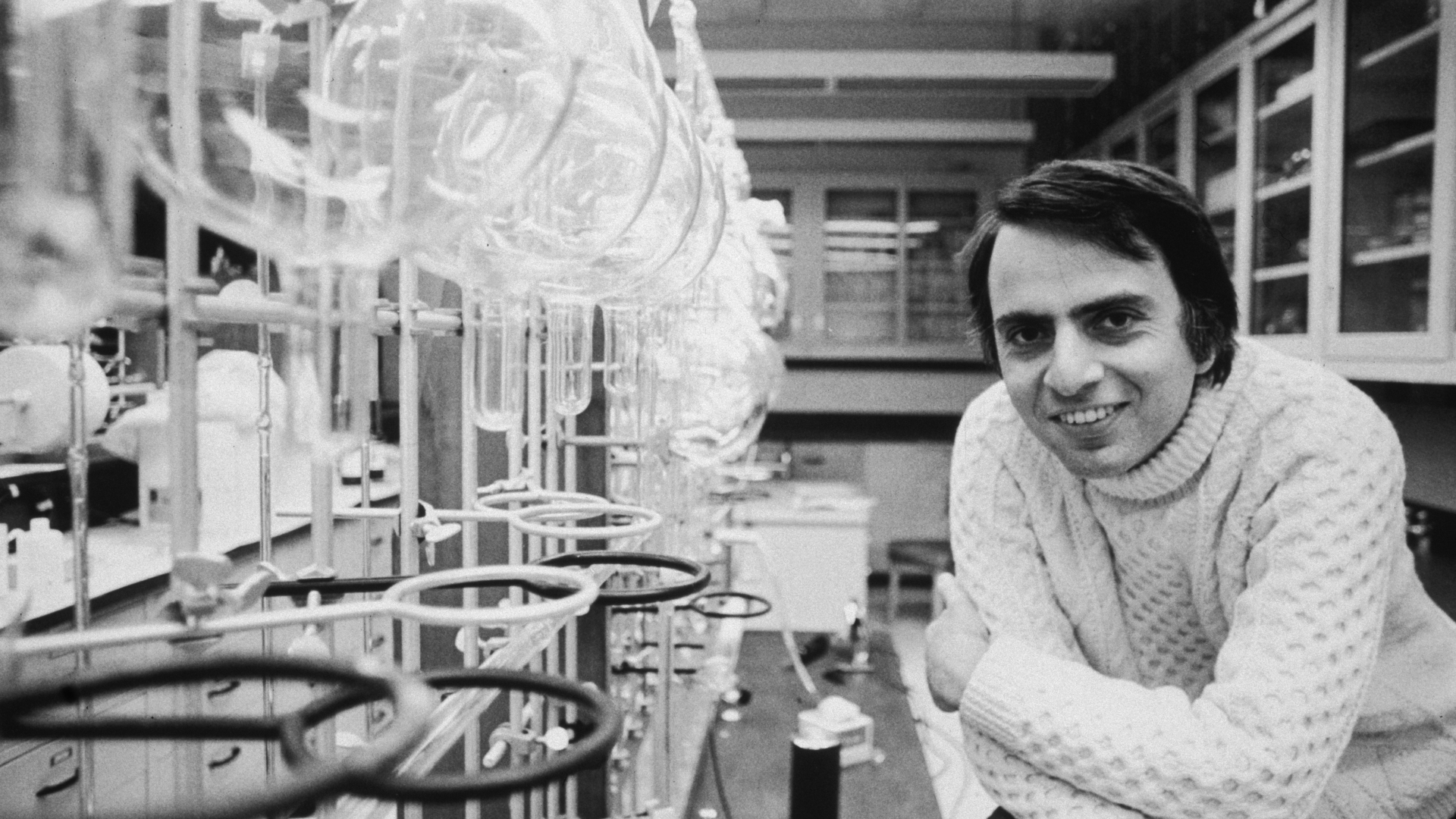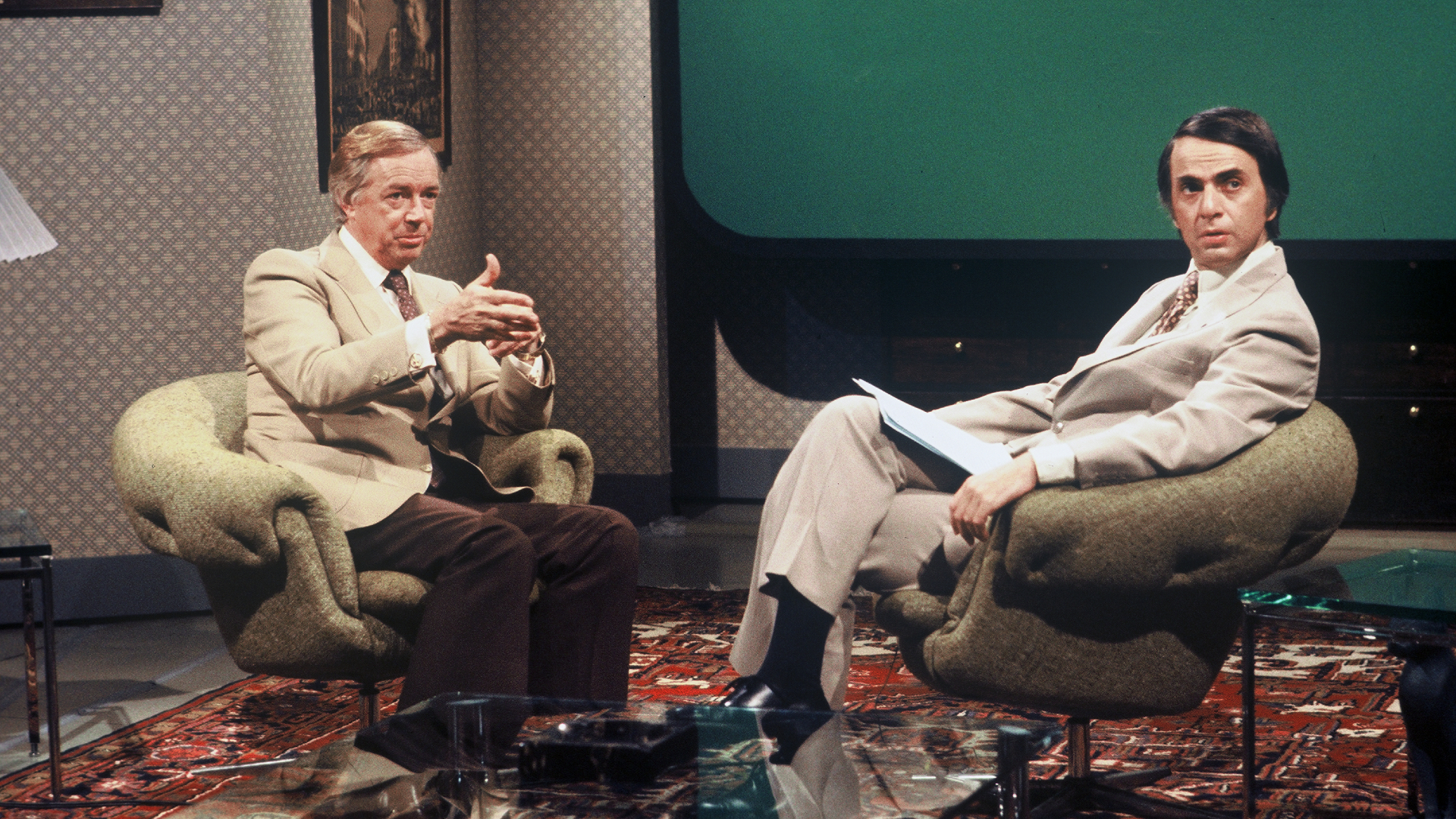Carl Sagan: Cosmos, Pale Blue Dot & famous quotes
A biography of renowned astronomer Carl Sagan

Astronomer Carl Sagan, called "America's most effective salesman of science" by Time magazine, spent much of his career translating technical scientific explanations into something easily digestible by the general public. As a natural teacher, Sagan educated people not only through classroom lectures but also through interviews and television shows. His 13-part TV series, "Cosmos," has been seen by over 600 million people in more than 60 countries. The show was so popular that it returned to television in 2005. [See also our overview of Famous Astronomers and great scientists from many fields who have worked in astronomy.]
Life on the pale blue dot
Carl Edward Sagan was born on Nov. 9, 1934, in Brooklyn, New York. He attended college at the University of Chicago, where he earned his Ph.D. in astronomy and astrophysics in 1960, at the age of 26.
After completing postdoctoral work, he taught at Harvard University. When that school declined to grant Sagan tenure status in 1968, he took a position with Cornell University in New York, serving as the director for the Laboratory for Planetary Studies and the associate director of the Center for Radio Physics and Space Research.
Diagnosed with the rare bone-marrow disease myelodysplasia, Sagan underwent three bone-marrow transplants over the course of his life. Due to complications from the disease, he contracted pneumonia, which led to his death on Dec. 20, 1996, at age 62.
Making Science Interesting
Although Sagan was most widely known for his scientific communication with the general public, he made many significant scientific contributions as well.
When Sagan was in graduate school, many scientists thought the planet Venus was similar to Earth. As part of his doctorate research, Sagan computed the first greenhouse model for Venus' atmosphere, which revealed a higher temperature than previously suspected. Later, he suggested that dust storms on Mars caused the seasonal changes observed on that planet, and he also wrote a series of papers on the organic chemistry of Jupiter's atmosphere.
As an advisor to NASA, Sagan helped design and manage the Mariner 2 mission to Venus, the Mariner 9 and Viking trips to Mars, the Voyager system to the outer solar system, and the Galileo mission to Jupiter. He also helped brief astronauts prior to their trips to the moon.
Sagan helped lay the groundwork for two new scientific disciplines: planetary science and exobiology, or the study of potential life on other planets. He co-founded and served as the first president of The Planetary Society, an organization dedicated to inspiring and involving the public in space exploration. And he promoted the Search for Extraterrestrial Intelligence (SETI) Institute, where he served as a trustee.
But Sagan was far more visible as a scientific educator than as a researcher. He was gifted at breaking down scientific concepts into explanations that the public could readily understand, while avoiding talking down to them. He authored hundreds of popular articles and more than two dozen books, and he frequently appeared in Time magazine — landing the cover on Oct. 20, 1980.
"Carl kept feet firmly planted in both the planetary research community and in the greater worlds of science communication and science policy," astronomers Yervant Terzian and Virginia Trimble wrote in the American Astronomical Society's obituary for Sagan.

Sagan's Books and TV Episodes
In 1977, Sagan began work on the television series "Cosmos: A Personal Voyage," serving as writer and presenter. The first show aired on the Public Broadcasting Service in October of 1980. Between new episodes and reruns, the show was the most widely watched series on U.S. public television for nearly a decade. The show won an Emmy and a Peabody award and was broadcast around the world. Sagan's book of the same name (Random House, 2013) stayed on The New York Times best-seller list for 70 weeks and was the best-selling science book ever published in the English language at the time.
In addition to "Cosmos," Sagan also appeared as a guest on "The Tonight Show Starring Johnny Carson" 26 times, calling it "the biggest classroom in history."
At Sagan's request, NASA commanded its Voyager 1 spacecraft to turn its camera on Earth, creating an image that came to be known as the "Pale Blue Dot," one of the most famous pictures of Earth from space ever taken. The photo is so iconic that NASA even released an updated version of the “Pale Blue Dot” to celebrate its 30th anniversary in 2020. Sagan used that name as the title of another book. The sequel to "Cosmos," Sagan's "The Pale Blue Dot" (Random House, 1994) toured the solar system and the galaxy, arguing for the necessity of planetary science and the exploration of Earth's closest neighbors. This book, too, was widely well-received by the general public.
An earlier nonfiction book by Sagan, "The Dragons of Eden: Speculations on the Evolution of Human Intelligence," (Random House, 1977) received the 1978 Pulitzer Prize for general nonfiction.
Although the majority of Sagan's work was nonfiction, he used fiction to present scientific principles in his 1985 novel "Contact" (Simon & Schuster, 1985). The story revolved around interactions between the human race and an advanced civilization of extraterrestrials. The novel sold over a million copies in its first two years of publication, and in 1997, it was released as a major motion picture starring Jodi Foster as main character Ellie Arroway (who was inspired by real-life SETI astronomer Jill Tarter).
In 2015, the Los Angeles Times announced that Warner Bros. Entertainment Inc. was working with Sagan's widow, Ann Druyan, on a film about the scientist's life. The production company hasn't released any details about the movie since the initial announcement.
In Sagan's New York Times obituary, then-President of the National Academy of Sciences Bruce Alberts said, "Carl Sagan, more than any contemporary scientist I can think of, knew what it takes to stir passion within the public when it comes to the wonder and importance of science."

Notable Carl Sagan quotes and excerpts from his books:
Carl Sagan Quotes and Book Excerpts
"Advances in medicine and agriculture have saved vastly more lives than have been lost in all the wars in history."
— "The Demon-Haunted World: Science As a Candle in the Dark" (Ballantine Books, 1997)
"The significance of a finding that there are other beings who share this universe with us would be absolutely phenomenal. It would be an epochal event in human history."
— Quoted in CNN obituary, December 20, 1996
"At the heart of science is an essential balance between two seemingly contradictory attitudes — an openness to new ideas, no matter how bizarre or counterintuitive they may be, and the most ruthless skeptical scrutiny of all ideas, old and new. This is how deep truths are winnowed from deep nonsense."
— "The Demon-Haunted World: Science As a Candle in the Dark" (Ballantine Books, 1997)
"Every kid starts out as a natural-born scientist, and then we beat it out of them. A few trickle through the system with their wonder and enthusiasm for science intact."
— Interview in the magazine Psychology Today (January 1996)
"For myself, I like a universe that includes much that is unknown and, at the same time, much that is knowable. A universe in which everything is known would be static and dull, as boring as the heaven of some weak-minded theologians. A universe that is unknowable is no fit place for a thinking being. The ideal universe for us is one very much like the universe we inhabit. And I would guess that this is not really much of a coincidence."
— "Can We Know the Universe?" in M. Gardner (ed.), "The Sacred Beetle and Other Great Essays in Science" (Plume, 1986)
"In a lot of scientists, the ratio of wonder to skepticism declines in time. That may be connected with the fact that in some fields — mathematics, physics, some others — the great discoveries are almost entirely made by youngsters."
— Interview in the magazine Psychology Today (January 1996).
"It is sometimes said that scientists are unromantic, that their passion to figure out robs the world of beauty and mystery. But is it not stirring to understand how the world actually works — that white light is made of colors, that color is the way we perceive the wavelengths of light, that transparent air reflects light, that in so doing it discriminates among the waves, and that the sky is blue for the same reason that the sunset is red? It does no harm to the romance of the sunset to know a little bit about it."
— "Pale Blue Dot: A Vision of the Human Future in Space" (Ballantine Books, 1997)
"It is the responsibility of scientists never to suppress knowledge, no matter how awkward that knowledge is, no matter how it may bother those in power; we are not smart enough to decide which pieces of knowledge are permissible and which are not."
— Quoted in Lily Splane's "Quantum Consciousness" (Anaphase II Publishing, 2004)
"It is the tension between creativity and skepticism that has produced the stunning and unexpected findings of science."
— "Broca's Brain: Reflections on the Romance of Science" (Ballantine Books, 1986)
"Our passion for learning ... is our tool for survival."
— "Cosmos" (Random House, 1985)
"The cure for a fallacious argument is a better argument, not the suppression of ideas."
— "The Demon-Haunted World: Science As a Candle in the Dark" (Ballantine Books, 1997)
"The fact that some geniuses were laughed at does not imply that all who are laughed at are geniuses. They laughed at Columbus, they laughed at Fulton, they laughed at the Wright brothers. But they also laughed at Bozo the Clown."
— "Broca's Brain: Reflections on the Romance of Science" (Ballantine Books, 1986)
"If the dinosaurs had had a space program, they would not be extinct."
— Quoted by NASA Administrator Michael Griffin in a NASA press release
"The job is by no means done. We will look for the boundary between the solar system and the interstellar medium, and then we'll voyage on forever in the dark between the stars."
— Quoted in CNN obituary, December 20, 1996
Further Reading
Join our Space Forums to keep talking space on the latest missions, night sky and more! And if you have a news tip, correction or comment, let us know at: community@space.com.
Breaking space news, the latest updates on rocket launches, skywatching events and more!

Nola Taylor Tillman is a contributing writer for Space.com. She loves all things space and astronomy-related, and always wants to learn more. She has a Bachelor's degree in English and Astrophysics from Agnes Scott College and served as an intern at Sky & Telescope magazine. She loves to speak to groups on astronomy-related subjects. She lives with her husband in Atlanta, Georgia. Follow her on Bluesky at @astrowriter.social.bluesky
